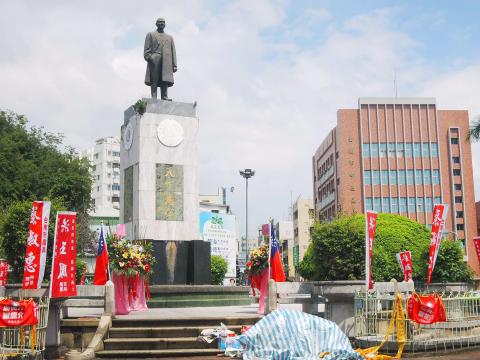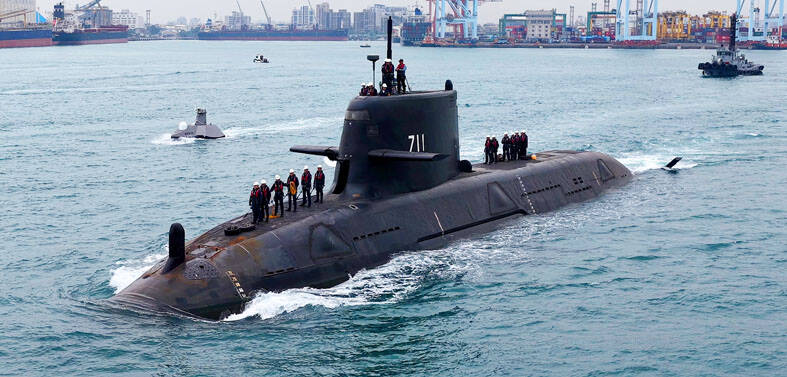Following a standoff between supporters and protesters at the Tang Te-chang Park in Greater Tainan yesterday, the Greater Tainan Government announced that it would delay a plan to relocate a statue of Republic of China founding father Sun Yat-sen (孫逸仙).
The controversy over the statue started in early February, when Northern Taiwan Society executive head Sherry Huang (黃淑純) complained that there was only a half-lifesize statue of 228 Incident hero Tang Te-chang (湯德章) on the periphery of the park, while a full-size bronze statue of Sun was prominently placed in the center.
Tang was a lawyer in Tainan during the 228 Incident and was burning a list of names of people who participated in the activities of the local Settlement Committee when Nationalist soldiers showed up to arrest him.

Photo: Hung Jui-chin, Taipei Times
He was severely beaten while he put up a fierce resistance in a bid to allow the list to be burned completely. He was executed the following day.
His actions saved the lives of a number of leading Tainan residents and students whose names were on the list.
The 228 Incident refers to an uprising in 1947 against the then-Chinese Nationalist Party (KMT) regime and the resulting brutal crackdown that left tens of thousands dead, and led to nearly four decades of martial law.
The city government had originally planned to relocate Sun’s statue to the Ka Ba Sua Elementary School’s Shueiyun campus in Dongshan District (東山) on Friday.
The KMT caucus in the city council, as well as the Greater Tainan KMT headquarters branch, strongly condemned the move and also criticized Greater Tainan Mayor William Lai’s (賴清德) actions.
The KTM city councilors took turns standing beside Sun’s statue to guard against it being removed and their resolve was bolstered by visits from others who protested against the decision to remove the statue.
There was even a flower basket allegedly sent by Sun’s granddaughter, Lily Sui-fong Sun (孫穗芳), reading: “Many thanks to the people of Tainan who stood guard for my family.”
City government supporters waved banners in front of the National Museum of Taiwanese Literature, which is near the park, and said that the city government was right in giving Tang justice because he was a victim of the 228 Incident.
Seeing the banners, protesters made a banner of their own, reading: “The founding father also wants his living rights.”
Meanwhile, the city government took down the scaffolding that had been erected around the statue and announced a delay in the relocation, but said that the relocation was inevitable.
The relocation is to safeguard the rights of residents and to protect a historical relic, the city government said, adding that other counties and cities had done the same thing.
The relocation of statues to be collectively stored in one location is very common, the city government said, adding that the relocation of the statue had nothing to do with politics.
The decision was completely legal and we would like to ask for the support of residents, the city government said.

US climber Alex Honnold is to attempt to scale Taipei 101 without a rope and harness in a live Netflix special on Jan. 24, the streaming platform announced on Wednesday. Accounting for the time difference, the two-hour broadcast of Honnold’s climb, called Skyscraper Live, is to air on Jan. 23 in the US, Netflix said in a statement. Honnold, 40, was the first person ever to free solo climb the 900m El Capitan rock formation in Yosemite National Park — a feat that was recorded and later made into the 2018 documentary film Free Solo. Netflix previewed Skyscraper Live in October, after videos

NUMBERS IMBALANCE: More than 4 million Taiwanese have visited China this year, while only about half a million Chinese have visited here Beijing has yet to respond to Taiwan’s requests for negotiation over matters related to the recovery of cross-strait tourism, the Tourism Administration said yesterday. Taiwan’s tourism authority issued the statement after Chinese-language daily the China Times reported yesterday that the government’s policy of banning group tours to China does not stop Taiwanese from visiting the country. As of October, more than 4.2 million had traveled to China this year, exceeding last year. Beijing estimated the number of Taiwanese tourists in China could reach 4.5 million this year. By contrast, only 500,000 Chinese tourists are expected in Taiwan, the report said. The report

Temperatures are forecast to drop steadily as a continental cold air mass moves across Taiwan, with some areas also likely to see heavy rainfall, the Central Weather Administration (CWA) said. From today through early tomorrow, a cold air mass would keep temperatures low across central and northern Taiwan, and the eastern half of Taiwan proper, with isolated brief showers forecast along Keelung’s north coast, Taipei and New Taipei City’s mountainous areas and eastern Taiwan, it said. Lows of 11°C to 15°C are forecast in central and northern Taiwan, Yilan County, and the outlying Kinmen and Lienchiang (Matsu) counties, and 14°C to 17°C

STEERING FAILURE: The first boat of its class is experiencing teething issues as it readies for acceptance by the navy, according to a recent story about rudder failure The Hai Kun (海鯤), the nation’s first locally built submarine, allegedly suffered a total failure of stern hydraulic systems during the second round of sea acceptance trials on June 26, and sailors were forced to manually operate the X-rudder to turn the submarine and return to port, news Web site Mirror Daily reported yesterday. The report said that tugboats following the Hai Kun assisted the submarine in avoiding collisions with other ships due to the X-rudder malfunctioning. At the time of the report, the submarine had completed its trials and was scheduled to begin diving and surfacing tests in shallow areas. The X-rudder,